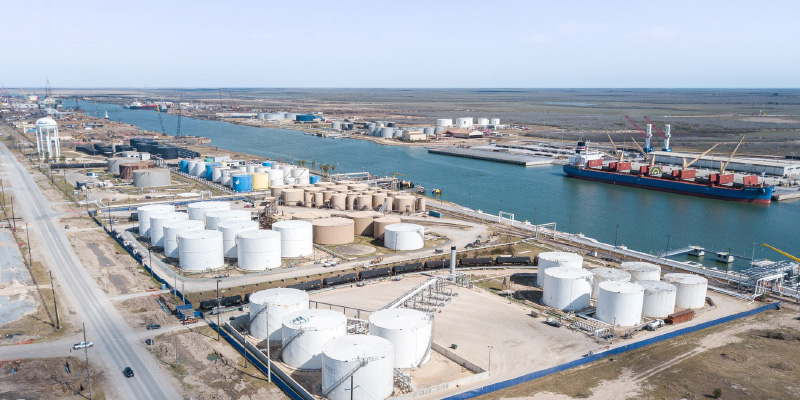
Founded in July 2015 and headquartered in Houston, Texas, Bluewing Midstream LLC has rapidly emerged as a key player in the energy infrastructure sector along the U.S. Gulf Coast. Specializing in the acquisition, development, and operation of bulk liquid terminals, their keen strategic initiatives have enhanced the logistics and storage capabilities for their petroleum product customers while providing workable solutions to industry problems in the region.
With terminal assets strategically situated in Texas, at the Port of Brownsville, Bluewing’s location serves as a critical gateway to South Texas, Mexico, and other international markets. Supporting this, the company’s facilities offer a comprehensive suite of services, including bulk storage, blending, heating, and transloading of various bulk liquid commodities such as diesel, gasoline, base oil, wax, jet fuel, LPGs, and ethanol. Seen as an innovative infrastructure company by their various customers, CEO Todd Reid explains that they are guided by four pillars: Safety, Technology, Service and Communication, which have been essential in their ongoing expansion plans.
He explains that, in response to growing customer demands, Bluewing commenced construction on its Phase II Expansion Project in May 2019 and began operations later the same year. This expansion added 300,000 barrels of new liquids storage capacity, capable of handling gasoline, diesel, jet fuel, and other petroleum products. Combined with existing assets, this brought the total storage capacity to approximately 1.1 million barrels.
“We were very excited to break ground on our Phase II expansion project and continue to build upon our existing operations,” Reid says, “Phase II allowed us to advance our strategic organic development vision while continuing to provide flexible and efficient terminal and logistics solutions to our customers.”
Phase III of the project includes the addition of four modes of transportation with tanks configured to ship and receive product by truck, railcar, barge or pipeline. This is expected to result in an additional 1.8MM Bbls of bulk-liquid storage capacity with 41 tanks ranging in capacity from 36,000 Bbls to 88,000 Bbls. Supported by 85 railcar spots with 40 automated loading positions.
Automation
A distinguishing feature of Bluewing’s operations is their commitment to technological innovation, particularly in automation. The company has implemented advanced systems that automate processes from scheduling to loading, significantly enhancing efficiency and transparency. Customers can log into the terminal automation system at any time to monitor their product’s status, providing real-time insights into loading and transportation activities.
Vice President of Engineering and Construction, Danny Malone, highlighted the benefits of automation in a recent interview, saying, “Everything is automated from the time the driver comes into the time he leaves, and this seamless integration of technology not only streamlines operations but also sets Bluewing apart from competitors that still rely on manual processes.”
Environmental Commitment
According to Reid, Bluewing has always placed a strong emphasis on environmental responsibility and the company utilizes next-generation, advanced vapor combustion systems to prevent emissions during terminal loading operations. These systems are designed to be super-clean and super-efficient, ensuring that pollutants are not released into the atmosphere. He continues that understanding the relevance of their impact on the environment is an offshoot of the leadership team’s experience.
Combined with this, is a clear vision for the company’s growth. Chief exec Todd Reid, who leads the company with his 28 (plus) years in the energy industry, and has been instrumental in steering the company’s strategic direction, is supported by Vice President of Commercial Operations, Amanda Luckey, and Vice President of Engineering and Construction, Danny Malone, who contribute their expertise in commercial operations and engineering.
Finding Solutions
Bluewing Midstream addresses the unique logistical hurdles of operating in the Gulf of Mexico through targeted strategies focused on resilience, regulatory compliance, environmental safety, infrastructure investment, workforce training, and advanced cybersecurity measures. We were keen to take a deeper look at their approach and were able to highlight specific areas that make a difference.
Extreme Weather Risk And Supply Chain Resilience
Reid advocates preparedness, and Bluewing Midstream is well aware of the Gulf’s weather volatility and has fortified their facilities to withstand adverse conditions. This includes developing comprehensive contingency plans to ensure the safety and continuity of its operations during hurricane season, such as emergency storage solutions and implementing alternative shipping routes to mitigate the risk of supply chain disruption.
Additionally, recognizing that adverse weather can delay shipments and drive-up costs, Bluewing has integrated supply chain risk management strategies into its logistics planning. By leveraging its strategic location at the Port of Brownsville, Bluewing can offer flexibility in distribution channels and is equipped to reroute shipments as necessary to ensure continuity.
Simplifying Paperwork
Navigating regulations is an important but time-consuming practice. Operating across multiple jurisdictions, Bluewing has invested in a compliance framework aligning with federal, state, and local regulations. This framework is particularly crucial given the port’s cross-border operations with Mexico, “Our in-house team regularly reviews regulatory changes to stay up-to-date and minimize operational delays,” says Reid.
This includes navigating the regional infrastructure limitations, such as port congestion. Although this is a challenge at major Gulf ports, Bluewing’s location at the Port of Brownsville, a less congested site than ports like Houston, allows it to avoid frequent delays. This tactical positioning provides a useful advantage in meeting delivery schedules and minimizing wait times for loading and unloading, which has led to further investment in infrastructure.
Bluewing is committed to modernizing and maintaining its infrastructure to ensure reliable operations. For instance, its Phase II expansion project, completed in 2019, added substantial storage capacity. Such investments enable Bluewing to manage operational disruptions while keeping capital expenditures in check.
Skill Shortages
Even a company as automated as Bluewing, still relies on skilled labour and they proactively invest in recruiting and retaining skilled professionals, focusing on attracting talent with specialized experience in energy and logistics. Additionally, Bluewing partners with local training organizations to cultivate a talent pool equipped with the required technical skills, particularly for terminal and storage operations.
“This involves prioritising safety training which is integral to our operational philosophy,” Reid says, “Employees undergo regular training sessions that comply with OSHA standards, ensuring they are well-prepared to handle the challenges of a high-risk environment. This ongoing commitment helps prevent accidents and maintain a high safety standard.”



